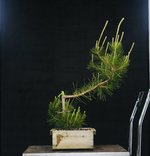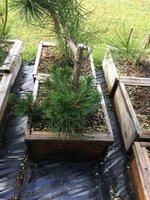Wow, I never heard just working on one side of tree. Have researched lots and it seems (articles, youtube, internet etc) do the whole tree at once. But it seems that they repot conifers that have been in bonsai pots, not nursery grown trees that have not been trained as bonsais. Is that the same for smaller size conifers purchased from nurseries? I've given my self an early xmas gift and bought a few other conifers and some deciduous from a specialty nursery in Connecticut. I currently have them in the ground (in their pots that I drilled holes in). I plan to repot them in colanders in the spring. Do you still recommend repotting and leaving all foliage intact? I know I'm asking lots of questions so thank you very much in advance!!!
Ah the internet! technically the only knowledge truly required to respond on the internet is the ability to type! Not surprising that there is a range of responses. Conifers are different from deciduous and not all conifers are the same. you have gone from asking about Pinus Nigra to general approach questions lumping in variety of species and source. One should always adapt for species difference, health variables and climate.
Generally speaking I recommend conifers be treated with more care in repotting and retaining sufficient foliage to aid recovery. Deciduous store more reserves in the root system and can be approached in a different manner.
Nursery grown tree's typically are up potted not repotted. This often results in more crossing roots and difficulty in developing a properly formed rot mass for long term success in a bonsai pot.
When you start out using a less invasive approach is a good idea. The 1/2 HBR is one I recommend as a safer route to take. With proper technique and experience, coupled with proper after care other options can be just as successful. You have indicated you are new to conifers so that is my recommended route in your circumstances.
Think about it this way, you are compromising the root system, but maintaining the engine that provides the power for recovery. The foliage. Also you are maintaining half the root ball to ensure up take of vital moisture and nutrients. Another step you can take to improve results is assess the root ball before you start and work on the weak side first. This keeps the strongest side for best health while new roots are formed to assist the weak side. Then when you do the strong side later, the new root ball will be strong and vigorous on the former weak side. Win,Win.
Have Fun
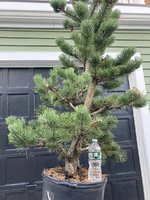

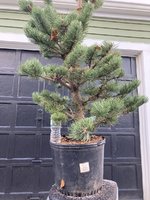
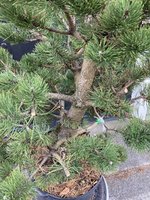 years. The trunk is about 4.4" wide and the overall height almost 4 feet. My plan is to cut the top off and repot it in a training pot some time in the spring. I just "trimmed to shape" some of the lower branches. On the last photo there are shoots coming from the trunk. I didn't think that pines grew new shoots from old wood.
years. The trunk is about 4.4" wide and the overall height almost 4 feet. My plan is to cut the top off and repot it in a training pot some time in the spring. I just "trimmed to shape" some of the lower branches. On the last photo there are shoots coming from the trunk. I didn't think that pines grew new shoots from old wood. 


 years. The trunk is about 4.4" wide and the overall height almost 4 feet. My plan is to cut the top off and repot it in a training pot some time in the spring. I just "trimmed to shape" some of the lower branches. On the last photo there are shoots coming from the trunk. I didn't think that pines grew new shoots from old wood.
years. The trunk is about 4.4" wide and the overall height almost 4 feet. My plan is to cut the top off and repot it in a training pot some time in the spring. I just "trimmed to shape" some of the lower branches. On the last photo there are shoots coming from the trunk. I didn't think that pines grew new shoots from old wood. 
